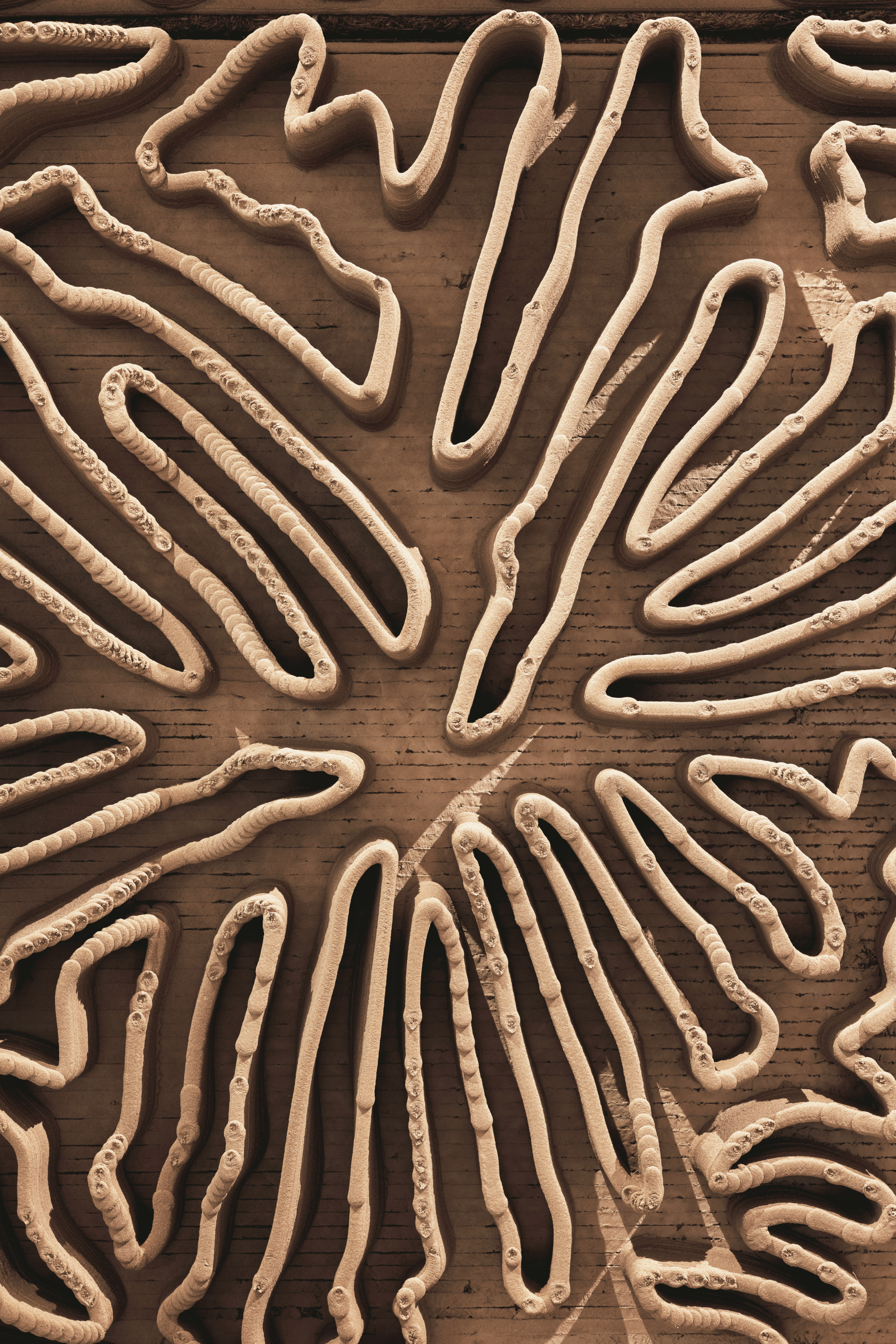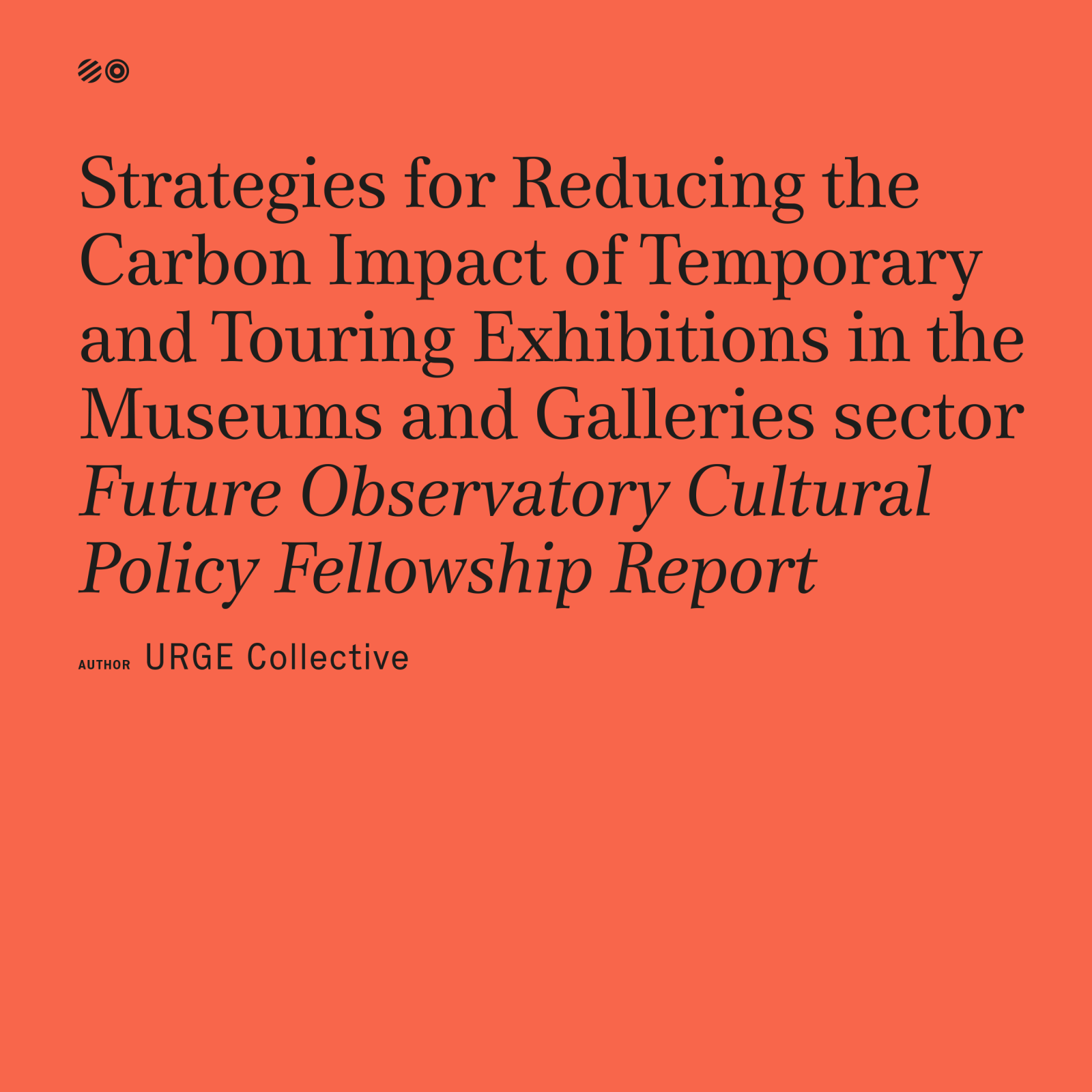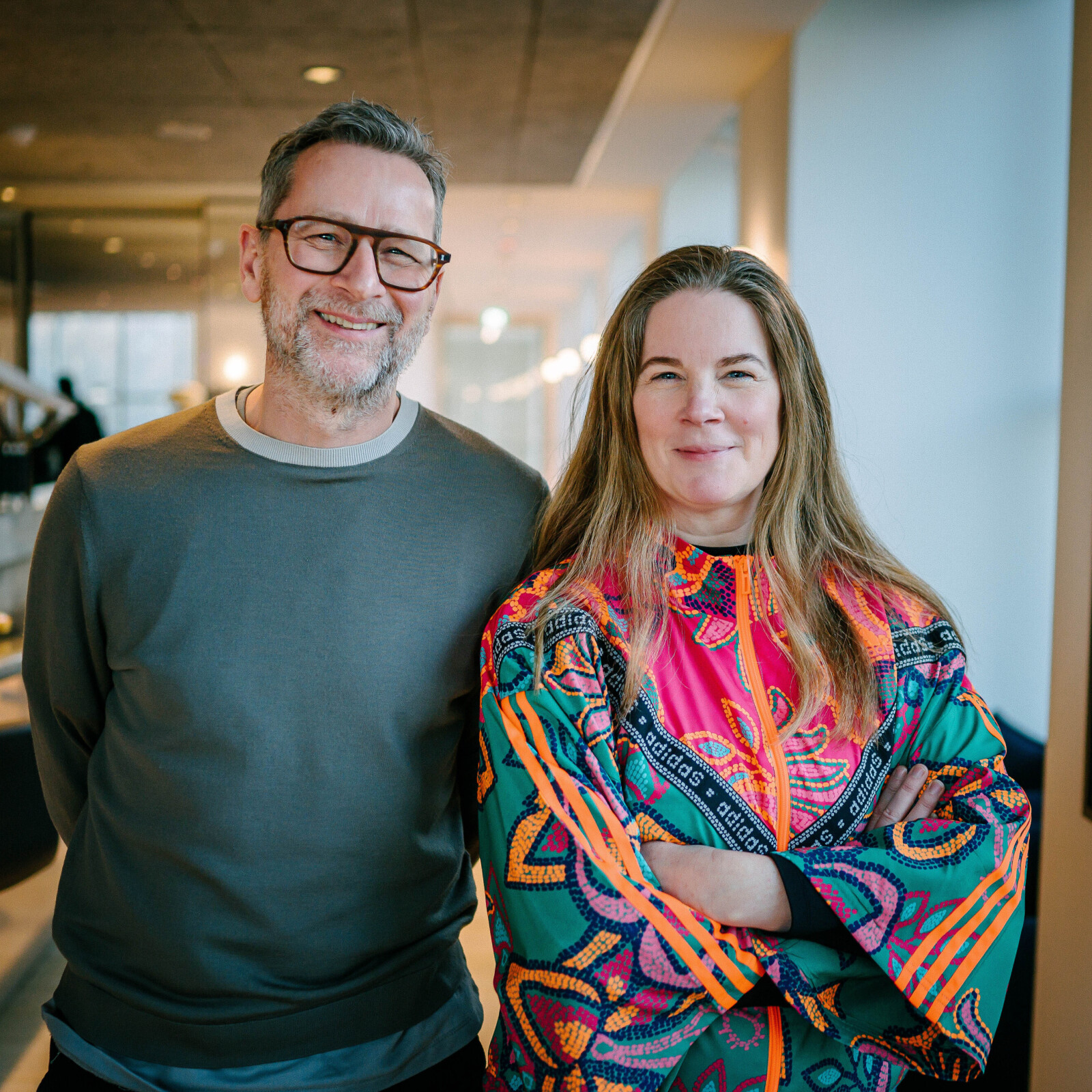Have you ever walked around an exhibition and wondered what happens to everything when the show is over? From the exhibits, to the beautifully-built walls, plinths and cases? Where does all this stuff go?
In October 2021, Waste Age opened at the Design Museum, an exhibition exploring design’s culpability in creating waste and its role in reimagining a less harmful future. What better moment, then, to examine the way in which exhibitions themselves create waste and how the curation, design and build of exhibitions can be reconsidered in the light of our climate crisis?
A year ahead of the exhibition’s opening, URGE Collective (a creative consultancy which works with organisations to help them respond to the Climate Crisis) proposed to the Design Museum that we conduct an environmental audit of Waste Age. The idea was to calculate the impact of Waste Age itself, covering everything from the transport of objects, to communications between staff, the construction of the exhibition, the materials it would be made of and how those materials were disposed of. The data produced could then be used to benchmark and aid decision-making for future temporary exhibitions.

Environmental Audit of Waste Age
The audit was conducted by URGE Collective’s Alexie Sommer, Ralf Waterfield and Sophie Thomas. It took a Life Cycle Analysis (LCA) approach and required collaboration with the museum’s curatorial, design, facilities and production teams to understand the full extent of the exhibition design process. Not only did the team record the impact of that process, it was also able to help inform and guide design decisions in order to reduce Waste Age’s eventual carbon footprint.
URGE created an Impact Model spreadsheet to monitor the three life cycle stages – pre-exhibition, live exhibition and post exhibition. URGE then captured data from stakeholder interviews, desk research, design reviews, email trackers, information from facilities, procurement, resource consumption, the production process and waste generation. This provided a detailed data inventory relating to energy, transport, weight and origin of exhibits and commissions, construction and waste. From this data, the Design Museum was then able to calculate a total exhibition impact in terms of tons of CO2e.
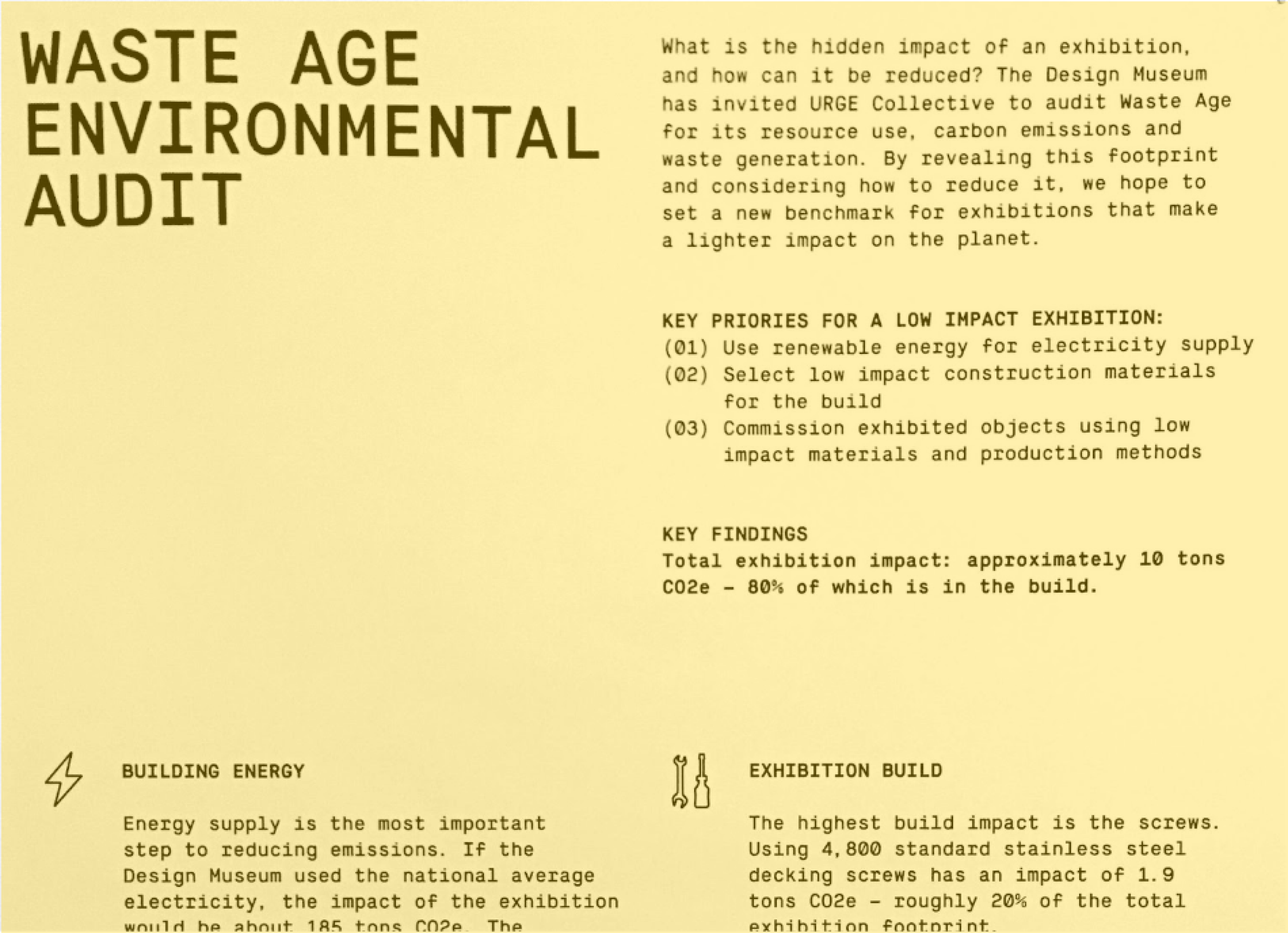
An Environmental Impact Working Group
Waste Age marked the first time that the Design Museum had measured the impact of an exhibition in this way. It presented a chance to build on what had been learned and the opportunities that the process had identified, both internally at the museum and across the broader museums sector.
URGE was invited to run a workshop to share the audit learnings and connect existing impact activity happening at the Design Museum in its Retail, Operations, Catering, Exhibitions and Finance teams. This was the start of a dedicated Environmental Impact Working Group for the museum which could go beyond the scope of the audit and examine areas such as staff activity and training, 2D & 3D design brief criteria, audience engagement, travel recommendations or the ability to source end-of-life homes for exhibition structures and materials that might otherwise go to waste.
The Environmental Impact Toolkit
The process of conducting the Waste Age audit revealed just how many decisions can affect the overall carbon footprint of an exhibition. Whether it’s choosing to ship an important exhibit from another part of the world, deciding how and if signage will be printed, specifying materials for walls, or even the way in which teams communicate with one another (every email has a carbon footprint!), every little thing adds to the overall total. If the Design Museum wants to reduce the carbon footprint of its exhibitions, what, how and when does it need to consider these choices?
To help answer those questions, the museum and Future Observatory commissioned URGE to collaborate on an Environmental Impact Toolkit consisting of a written guide to reducing the environmental impact of exhibition design and an updated and open source Impact Model. The guide examines the opportunities for reducing impact across areas including shipping and transport, programming, design and construction, materials, communications and energy use. It looks at where impacts are made in those areas and what to consider in order to reduce them.
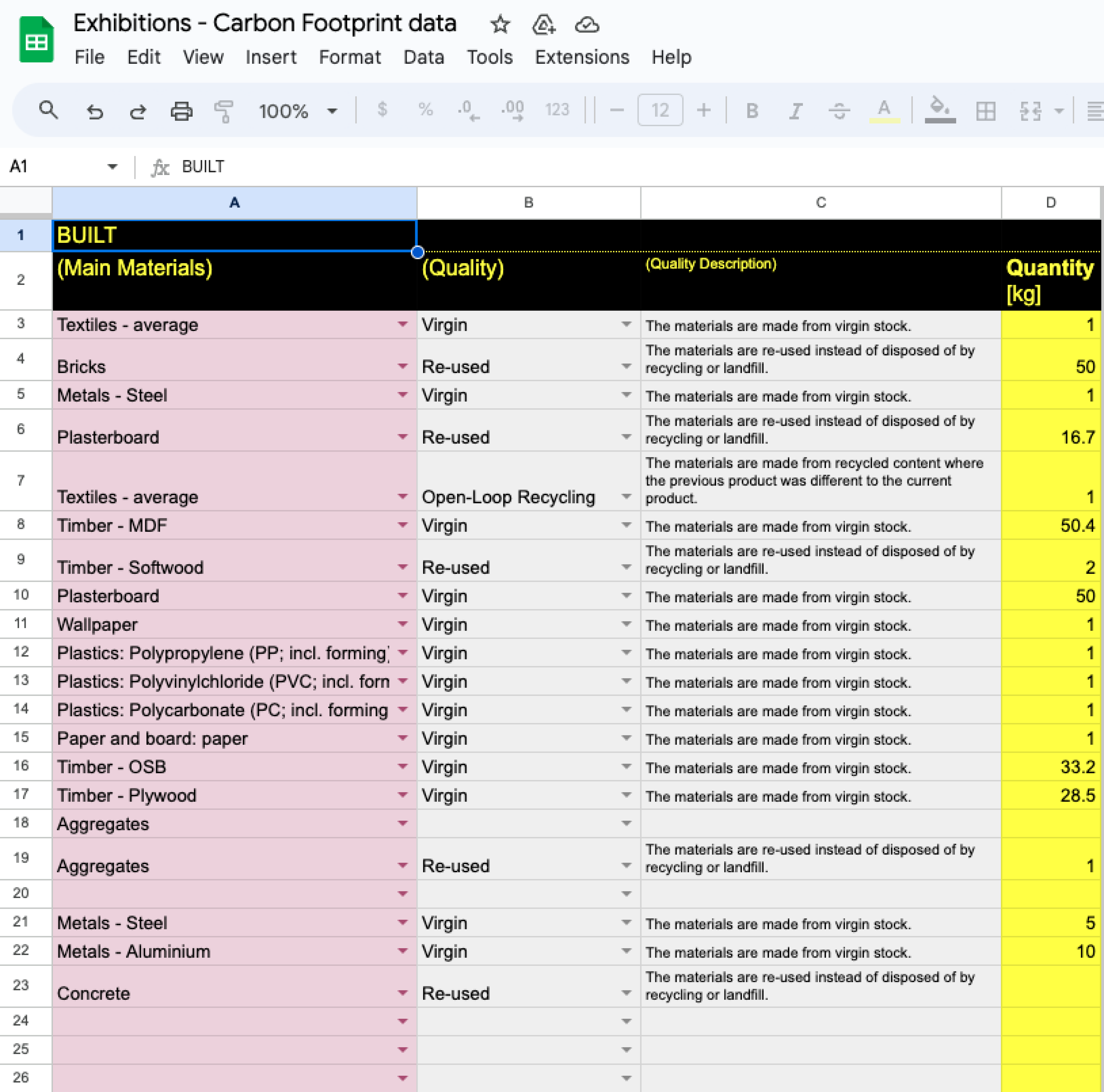
In addition, the guide advises on how to embed the consideration of impact reduction in the museum’s design process and how to work with commissioned designers, contractors and suppliers to communicate and deliver on the museum’s ambition to reduce its impact, develop effective ways of working and ensure it captures the information needed in order to measure its carbon impact in future.
The updated Impact Model was designed to help the museum track and calculate the carbon emissions related to each exhibition. But as well as recording data, it is also intended to aid decision-making during the design process itself, allowing the exhibition team to compare the consequences of, for example, choosing one material over another.
While the Toolkit was created for the use of the Design Museum itself, it was always intended to be shared with the wider museum community. In March 2023 the Design Museum and Future Observatory, with URGE, ran a workshop for the sector in order to share the toolkit, ask for feedback to help refine it and discuss how other institutions are addressing their impact. Museums present included the Natural History Museum, Science Museum, National Maritime Museum and the V&A. Stakeholders such as exhibition designers and groups working in the sector including Julie’s Bicycle were also represented.
Feedback from this session was then incorporated into the final version of the Toolkit which was released via the Design Museum website in order that the sector at large could use and adapt it for their own purposes.
Recommendations for the future
As part of its Cultural Policy Fellowship research programme, Future Observatory has commissioned a series of reports investigating current and future strategies for minimising the carbon impact of the UK cultural sector, supported by the Department for Culture, Media & Sport (DCMS).
Building on our previous work in this area, URGE was asked to write one of these reports, focussing on the impact of the design and build of temporary and touring exhibitions in the UK museums and galleries sector. The report incorporates findings from the Waste Age environmental audit and makes reference to the Design Museum Guide and Impact Model as well as incorporating feedback from our museum sector workshop and wider discussions. In addition, research was carried out with a range of stakeholders including Gallery Climate Coalition, Anaïs Aguerre of Bizot Group, contractors Factory Settings and US group BARDER, a platform for the re-use of exhibition assets and display materials.
The resulting report sets out the challenges that museums and galleries face in endeavouring to design and build temporary exhibitions with a reduced environmental impact as well as making recommendations for ways of working and resources that could overcome these challenges in future.
A version of the report has now been published by Future Observatory and is available to download here.
